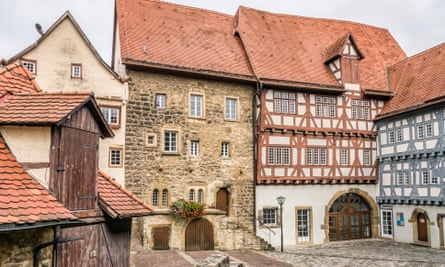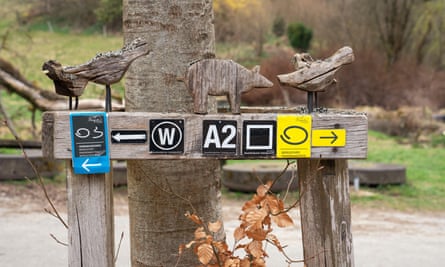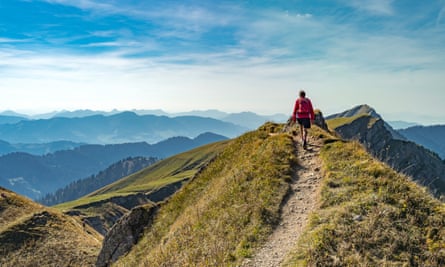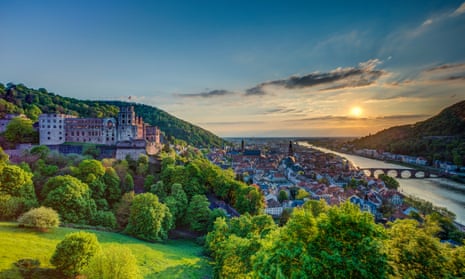The morning sun is shimmering through the forest as my wife, Melanie, and I shuffle upward along the extremely rewarding Himmelsleiter (sky ladder) hiking route near Heidelberg Castle. Verdant rolling hills frame the refurbished brownstone ruins of the palace grounds. Our increasingly laboured breathing is the rhythmic bass drum to our march, with our fully packed rucksacks making us earn each step. Moses, our pint-sized rescue pup, runs up and down the mossy stones with enviable ease.
Most are content to take in the castle sights and return to the comforts of Heidelberg’s old town city centre for a beer. Not us. There’s a cursive blue “N” we need to follow over the next few days along western Germany’s Neckar River. This is the Neckarsteig – one of Germany’s wildly impressive Fernwanderwege, or long-distance hiking trails.

The Neckarsteig is a nine-stage trail stretching 127km (79 miles) from Heidelberg to the spa town of Bad Wimpfen. Mark Twain himself wandered around this region, exploring by foot and raft when he wasn’t busy griping about the “awful” German language. Legend has it that the Neckar helped the author work through his writer’s block and inspired one of the rafting scenes in Huckleberry Finn. I can’t say I walked away with quite the same career-changing literary epiphany, but I did come home with an appreciation for Germany’s love of the trail.
As wonderful as the Neckarsteig is, it’s far from an anomaly in hiking-obsessed Germany. No matter where you might find yourself in the Bundesrepublik, chances are you’re within a couple hours journey of a Fernwanderweg. River trails are often traced by the Deutsche Bahn, Germany’s primary rail operator, allowing for straightforward planning for hikers looking to cover a couple of stages over a weekend before jumping back on the train. Even pancake-flat Berlin has the 217km Märkischer Landweg in its back yard, complete with detailed signage highlighting nearby sights and distances to surrounding towns.
A look at the digital hiking map from Wanderbares Deutschland pulls up a whopping 156 Fernwanderwege across the country. Not only are these trails impressive, but they’re easily accessible with public transport. It’s a dream come true for an American who grew up surrounded by more cars than people, where nature is walled off by comically wide highways and car parks twice the size of a football pitch. It turns out the grass truly is greener when you can actually see it.

The Neckarsteig was not my first romp along Germany’s trails. My introduction to them came by accident during a weekend trip to Königswinter, an hour south of Düsseldorf, where I lived for three years on first moving to Germany. While hiking aimlessly I noticed a white streak on a blue background with the word “Rheinsteig” underneath, painted on trees and not unlike the famous white “blazes” of the Appalachian Trail. I later learned that the Rheinsteig is a 320km trail wrapping around the Rhine River. Before long, we had numerous trips planned to hike portions of the surrounding Fernwanderweg.
Germany spoils its hikers. It wasn’t until I started travelling more regularly across Europe – from Portugal to Romania – that I fully comprehended that this whole hiking business isn’t a shared passion across the continent. Only its Germanic neighbours appear to offer similar hiking amenities, such as travel discounts and easy-to-spot waymarking.
Planning a hiking holiday in Germany is a cinch, with a number of the Fernwanderwege offering apps and GPX downloads for easy planning. It’s all a blissful digital aberration in a country notorious for its love of fax machines.
So find a Steig or Weg that speaks to you, grab your boots and pack a rucksack for a worry-free ramble around vineyards, castles, mountains and lakes before kicking back at the village Stube with a glass of local wine or a pint and some tavern fare. After a day on the trails, you’ve earned it.

Find your Fernwanderweg
Wanderbares Deutschland offers the most extensive look at Germany’s long-distance hiking portfolio.
A quick look at the digital map shows that although you can find something in every corner of the country, the western and south-western corners of the country offer the most options. You’ll find hilly, forested trails in western and central Germany, with the Black Forest, Allgäu, and Bavaria hosting the more mountainous routes.
Once you have an idea of where you want to head, look at the websites of regional tourism boards. They’re also happy to answer questions. Not only do states and cities have their own tourist boards, but many of the long-distance hiking trails do, too – often with English websites. For instance, if images of stone castles and vineyards along the Moselsteig catch your eye, Google “Moselsteig” and you’ll find the official English page, with more about the stages and, in many cases, download GPX files.
Getting to your trailhead
There’s no hard and fast rule, but some places to stay in villages along a long-distance hiking trail often charge a couple of euros tourist tax on top of the nightly rate. This buys walkers free public transportation within the region, so you can keep your luggage in one spot and use the train to reach the start of each day’s hike. Ask your host or hotelier if there are any travel discounts where you’re staying.

Comments (…)
Sign in or create your Guardian account to join the discussion